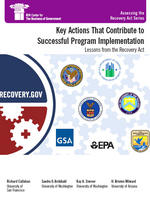
Key Actions That Contribute to Successful Program Implementation: Lessons from the Recovery Act

Historically, spending under stimulus legislation tended to peak after a recession was over, oftentimes creating inflation instead of jobs. To avoid this, the Recovery Act mandated tight timeframes, with 70 percent of the money required to be spent within 17 months to generate jobs. There was significant concern that this rapid spending might result in an estimated $50 billion in waste, fraud, or abuse. Accordingly, there were stringent transparency and accountability requirements embedded in the law.
The scale of spending – equivalent to almost an additional year of spending on top of regular spending – and the stringent spending requirements posed significant implementation challenges to federal executives. How did these executives respond? This report is based on a series of case studies and interviews with program-level executives who were personally engaged with implementing specific programs.
The authors found that executives created new models for program design, innovated new implementation procedures, and developed new ways of engaging stakeholders and funding recipients. The authors also identified a set of common actions taken by these federal executives to meet the Recovery Act’s requirements that could be applied in the future by those facing similar challenges to achieve large-scale results under tight deadlines.



